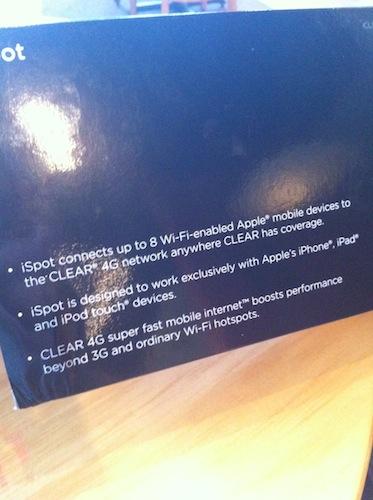
What's Good: The price point is very good - for $25, you get unlimited 4G connectivity.
What's Bad: The iSpot doesn't offer 3G as a backup, so you're out of luck if you travel outside of a 4G market.
The Verdict: The iSpot is targeting a niche demographic, but the price point is low enough that I expect people to jump on it.
Significant strides have been made to lower the price of connectivity over the past few years, and as of late, we've seen carriers offer mobile hotspot capabilities through their flagship smartphones. Instead of paying $60 for mobile broadband service, the casual user can add a $29.99 feature on top of their existing smartphone plan, and experience the benefits of mobile broadband for a cheaper price.
Clear's iSpot takes the mobile broadband idea to a whole new level. Marketed specifically as a hotspot for iPad, iPod, and iPhone users, the iSpot is a relatively inexpensive way to offer WiMAX connectivity to devices that wouldn't otherwise experience next-generation data speeds. For $25, you get unlimited 4G connectivity - quite the good deal, given that fully functional hotspots run in the $60 range per month. It's a niche product, but is the iSpot worth considering by Apple fans?
With a pebble-like design and glossy white exterior, the iSpot resembles a device that Apple would make. You'll find a miniUSB charging port (sadly, it's not microUSB) on the left side of the device, while the power button and dual LED status indicator is on the top of the unit. The battery slot is located on the bottom of the device, and is covered by a battery door with a handy list of possible LED colors you'll see during your time with the device (solid red means good WiMAX connectivity, solid blue means Wi-Fi is available, etc.).
You can access the admin control panel by plugging http://192.168.1.1 into the web browser on an iSpot-connected device. Type in the default password printed on the back of the device (which can be changed), and you're in. While logged in, you're able to see important things like battery status, total number of users on the device, signal strength, and connection uptime.
I tested the iSpot in two areas in Charlotte, and while connectivity speeds were very good, they were often inconsistent. The iPhone averaged a rough download speed of 2.2 Kbps and an average upload speed of about 700 Kbps. As with other WiMAX-equipped devices like the HTC EVO 4G and Overdrive, connectivity seemed to be across the board. At times, I would get download speeds of 1.5 Kbps, and other times, it would be 3.5 Kbps. In the past, I've had better speed numbers in high-density areas like the middle of uptown, so it may have been the fact that I'm at the edge of Charlotte's WiMAX coverage.
As those with 4G-enabled devices will attest, WiMAX kills battery life. Thankfully, the iSpot ships with a gigantic 2,700 mAh battery to handle the workload. Using it continuously, I was able to get just over four hours of use out of it, which is right around Clear's estimates.

If you're an iPad, iPod, or iPhone user that lives in a WiMAX market and you want the option to browse at 4G speeds while on the go, the iSpot is worth considering. The downside? It only works with Apple's iPortables, so those hoping to score a cheap internet tool are out of luck. Price-wise, it's $25 per month for unlimited service with no contract, making it an affordable option for iPod-toting customers that live in 4G-enabled markets, or iPhone users dissatisfied with data connectivity in their area.
It excels at its assigned tasks, but if it was me, I'd lean towards purchasing a phone with mobile hotspot capabilities. It's $5 more in most cases, but it offers me the ability to connect any Wi-Fi equipped portable without giving it a second thought. More importantly, while 4G coverage is expanding at a rapid pace, there's still a lot of medium and large cities that aren't covered, making it frustrating if you travel on a regular basis.